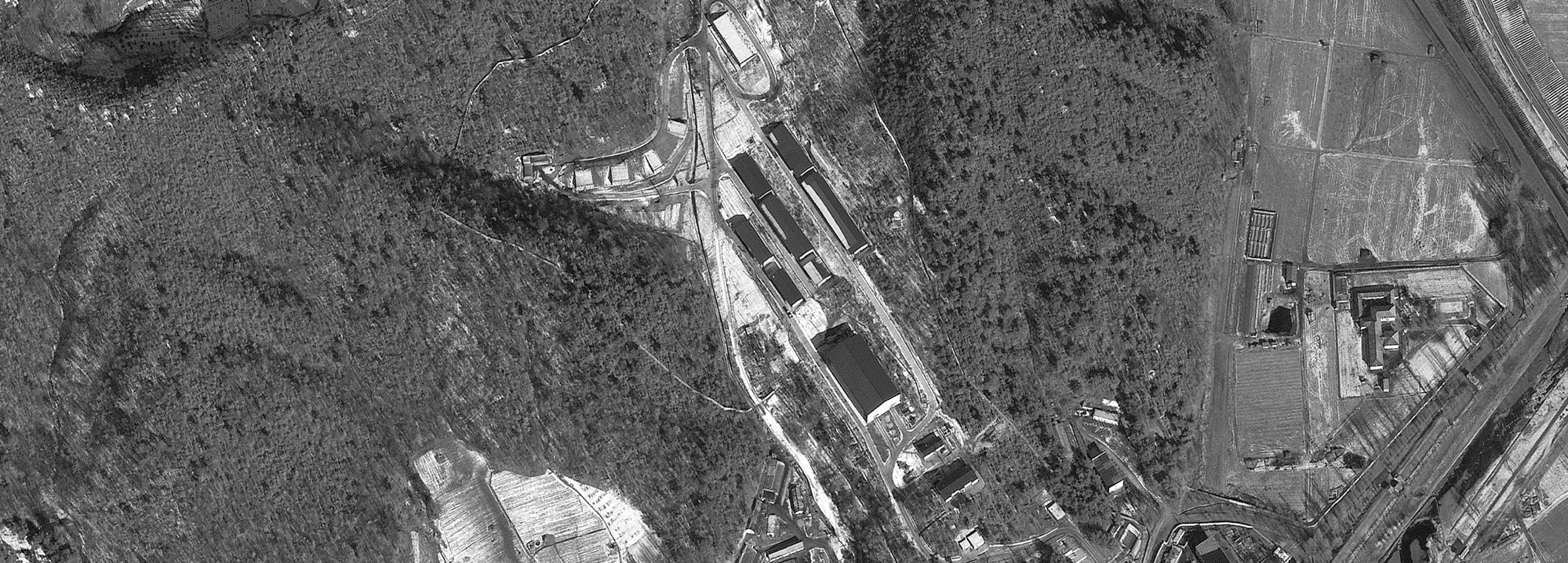
Unique Facility in the Sanum-dong-Namgung-ni Area
Key Findings
- A new facility in Ippul-tong is speculated by some to be a storage facility for ballistic missile transporter-erector-launchers (TELs), mobile-erector-launchers (MELs), or transporter-erectors (TEs).1
- However, there is no conclusive evidence that the facility is involved in supporting ballistic missile or weapons development activities.
- While some characteristics of the facility are typical of missile-associated facilities and could accommodate related activities, they are outnumbered by other factors that indicate otherwise.
- This report also refutes speculation that some of the structures are raised missile firing positions or entrances to an underground facility. Though there are indicators suggesting these structures could instead be used for storing gravity-fed liquid petroleum products or liquid waste, they lack elements that are typical of other such known facilities.
- The facility remains operational as is indicated by vehicle movement and activity at the facility’s greenhouse.
- The negation of information is often just as important as confirmation and such efforts by Beyond Parallel focus the public’s interest and policy discussions upon the facts that matter—real capabilities.

An important, and often overlooked, aspect of the Korea Chair and Beyond Parallel’s continuing project to identify and document North Korea’s ballistic missile and weapons of mass destruction (WMD) infrastructure is that the negation of information is often just as important as confirmation. These efforts focus the public’s interest and policy discussions upon the facts that matter—real capabilities. Such is the case for a unique storage facility constructed during 2017 located immediately east of North Korea’s ballistic missile and military research and development facilities in the Sanum-dong-Namgung-ni area. Speculation as to the function of this new facility has focused upon it being a storage facility for ballistic missile transporter-erector-launchers (TELs), mobile-erector-launchers (MELs) or transporter-erectors (TEs) produced in nearby factories.
Provisionally identified as the Ippul-tong Storage Facility (39.154549 N, 125.798990 E) it is located 2.3 kilometers east of the Sanum-dong-Namgung-ni area and 2.5 kilometers southeast of the Kim Jong Un National Defense University (involved in ballistic missile and WMD research and development) within the confines of a pre-existing small factory. This proximity, while suggestive, is not conclusive evidence that the facility is also involved in supporting ballistic missile or weapons development activities. Construction of the Ippul-tong facility began during the last week of April 2017 and was essentially complete in October 2017. With the exception of the construction of a new building in the northern corner during late-2019 only minor changes (e.g., ground clearing for drainage or gardens, etc.) have been observed within the facility since its construction. The facility encompasses approximately 125,500 square meters surrounded by its own security perimeter (a wall) and consists of 27 buildings (including entrances, guard positions, etc.). Among these are nine warehouse/storage buildings, two office or administration buildings and four smaller structures partially cut into a hillside, all of which are connected by a paved road network with wide-radius curves. That the facility is operational is indicated by the movement of vehicles and supplies, the changing pattern of tire tracks on the roads and activity at the facility’s greenhouse in imagery to date.
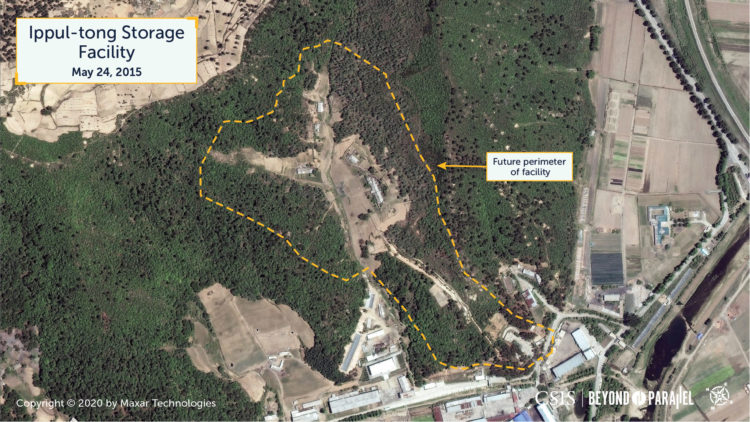
The Ippul-tong Storage Facility as seen on May 24, 2015. The facility has not yet begun construction. (Copyright © 2020 by Maxar Technologies) 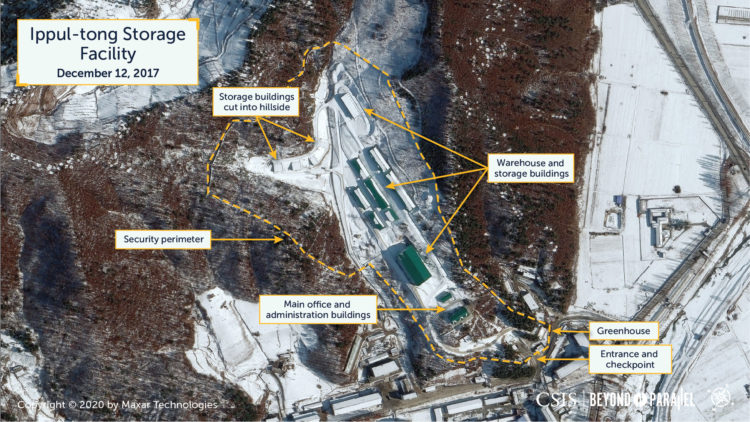
The Ippul-tong Storage Facility as seen on December 12, 2017, approximately eight months after construction began in April 2017 and two months after completion of the facility. (Copyright © 2020 by Maxar Technologies) 
The Ippul-tong Storage Facility as seen on April 9, 2018, approximately one year after construction began in April 2017. (Copyright © 2020 by Maxar Technologies) 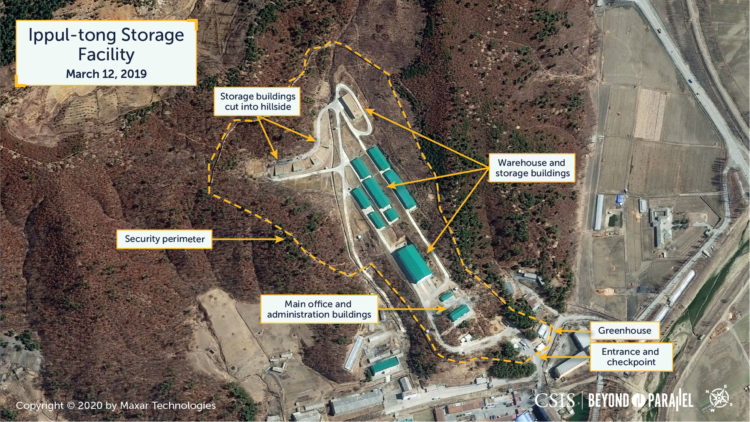
The Ippul-tong Storage Facility as seen on March 12, 2019. (Copyright © 2020 by Maxar Technologies) 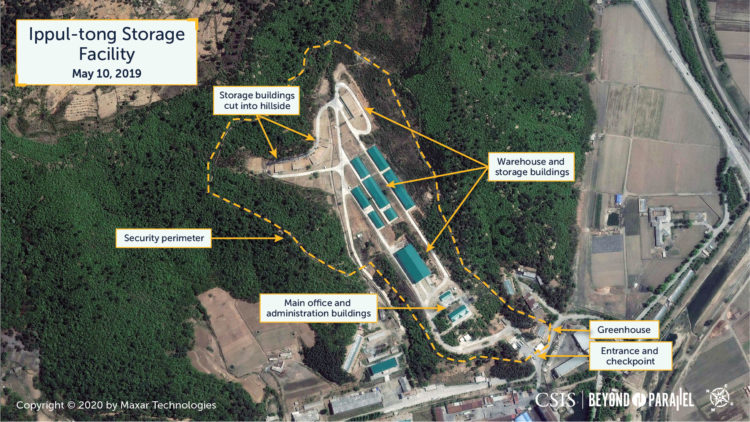
The Ippul-tong Storage Facility as seen on May 10, 2019. (Copyright © 2020 by Maxar Technologies) 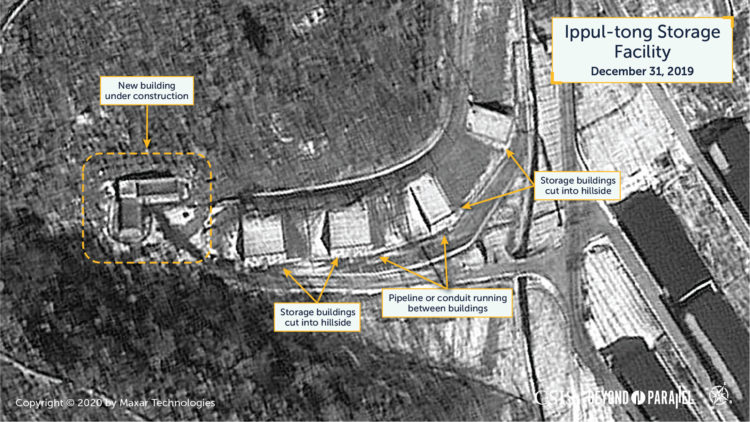
The Ippul-tong Storage Facility as seen most recently on December 31, 2019. A new building appears to be under construction. (Copyright © 2020 by Maxar Technologies) 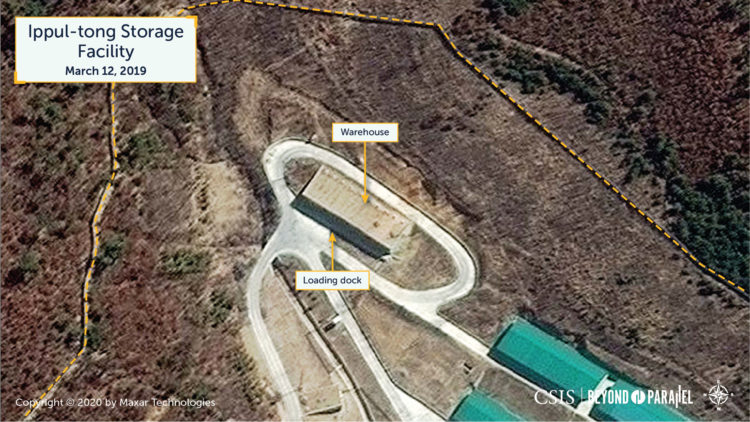
Close-up view of the warehouse and loading dock at the Ippul-tong Storage Facility as seen on March 12, 2019. (Copyright © 2020 by Maxar Technologies) 
Close-up view of the warehouse, storage, and maintenance buildings at the Ippul-tong Storage Facility as seen on March 12, 2019. (Copyright © 2020 by Maxar Technologies) 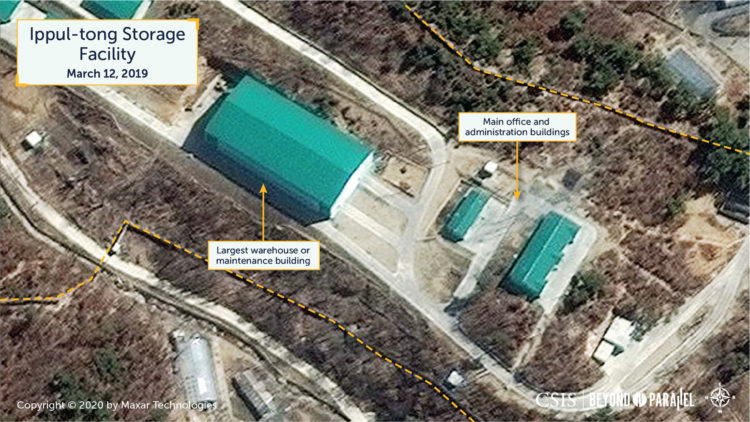
Close-up view of the largest warehouse or maintenance building and main administrative buildings at the Ippul-tong Storage Facility as seen on March 12, 2019. (Copyright © 2020 by Maxar Technologies)
The largest warehouse/storage building, while not a drive-through structure, is large enough (approximately 30-meters-by-60-meters) to accommodate most TELs, MELs or TEs known to be produced by North Korea. The wide-radius curves and two road loops are somewhat typical of missile-associated facilities and could easily accommodate known launchers. Such characteristics are, however, outweighed by a number of factors, including: 1) the facility does not match the configuration or layout of known ballistic missile bases, production, storage or maintenance associated facilities; 2) in comparison to known ballistic missile associated facilities there is simply not enough supporting infrastructure in type and number; and 3) with the exception of the very earliest ballistic missile facilities, all ballistic missile associated installations are located in far more remote areas.
Located within the northern loop road are the four small structures partially cut into a hillside (two are approximately 17-meters-by-16 meters and two are approximately 16-meters-by-10-meters). It has been speculated that these structures are raised missile firing positions or entrances to an underground facility. These conjectures are unlikely for a number of factors, including: 1) there are no reasonable operational requirements for such firing positions at this location; 2) they do not match known North Korean practices for firing positions; 3) there are small vents on the uphill side of each roof that generally preclude their use as firing positions; and 4) there are no approach aprons on the downhill side of the structures as would be expected for underground facilities and entrances to known underground facilities are entirely different than what is observed here. Close examination of the available satellite imagery, however, also shows: 1) the increasing size of ground stains likely from liquid spillage on the loop road above the four structures partially cut into the hillside; 2) what appears to be a pipe/conduit connecting the downhill sides of these structures together and extending south across a small drainage ditch; 3) the vehicles most frequently observed on the road above the structures and at the facility’s entrance appear to be tanker trucks; and 4) roof vents on the uphill side of the structures indicate underground storage. Taken as a whole this suggests that these structures are being used for the storage of some type of gravity-fed liquid petroleum products or liquid waste (potentially hazardous). Yet, the overall configuration and layout of the facility and absence of any significant loading/unloading stations does not match the characteristics of known surface or underground liquid petroleum products or liquid waste storage facilities.
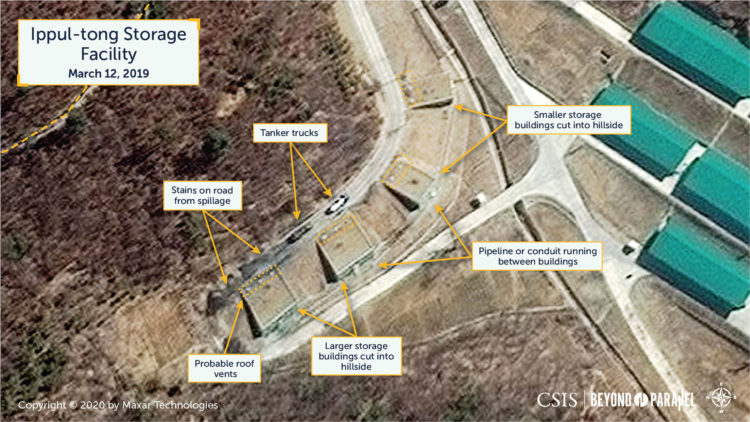
Close-up view of the ground stains, tanker trucks, a pipeline or conduit, and roof vents at the Ippul-tong Storage Facility as seen on March 12, 2019. This suggests that the facility may be storing gravity-fed liquid petroleum products or liquid waste. (Copyright © 2020 by Maxar Technologies) 
Close-up view of the of the entrance and another tanker truck at the Ippul-tong Storage Facility as seen on March 12, 2019. Continued movement of vehicles and activity at the greenhouse indicates the facility is operational. (Copyright © 2020 by Maxar Technologies) 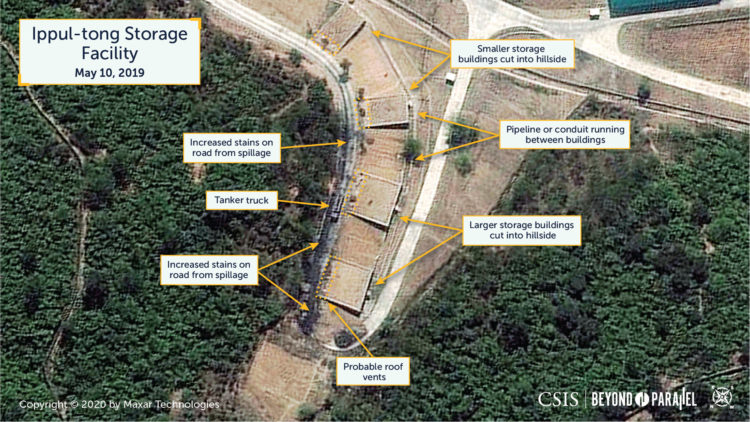
Close-up view of the ground stains, tanker trucks, a pipeline or conduit, and roof vents at the Ippul-tong Storage Facility as seen on May 10, 2019. This suggests that the facility may be storing gravity-fed liquid petroleum products or liquid waste. (Copyright © 2020 by Maxar Technologies) 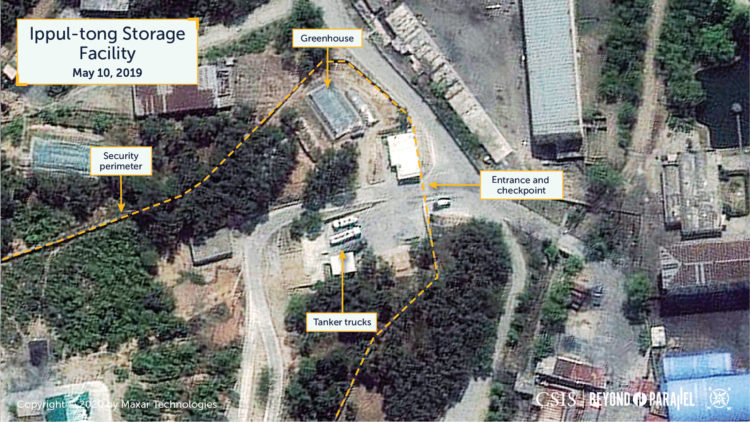
Close-up view of the of the entrance and tanker trucks at the Ippul-tong Storage Facility as seen on May 10, 2019. (Copyright © 2020 by Maxar Technologies)
There is no evidence that the Ippul-tong facility is being used for the storage or maintenance of ballistic missile TELs, MELs or TEs. While waiting for additional information concerning the facility’s function, it may tentatively be considered a storage facility for some class of liquid petroleum or liquid waste products; a maintenance facility for equipment and vehicles supporting this function and associated part/equipment storage.
References
- The author would like to thank both Jacob Bogle and Nathan Hunt for their input during the preparation of this report. ↩
